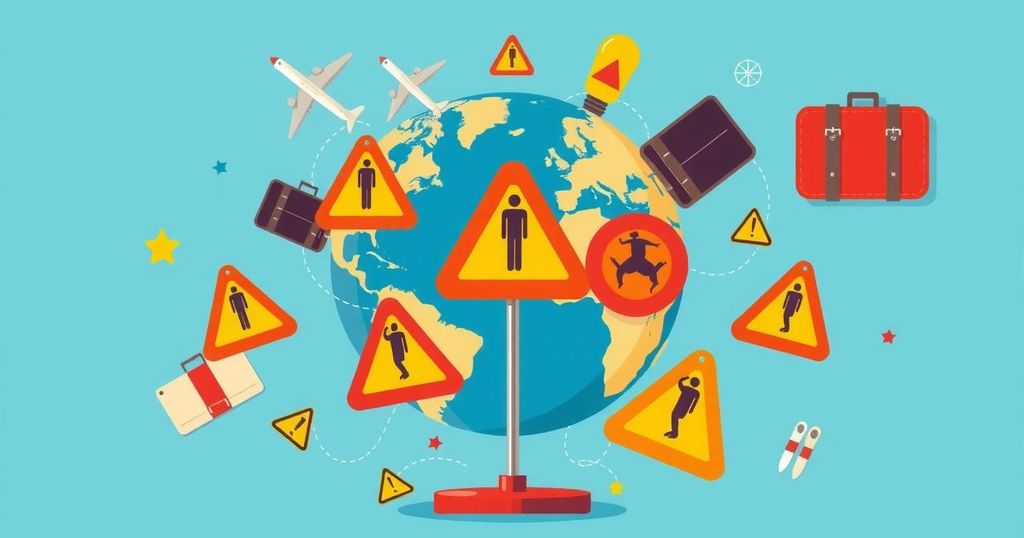Australia’s Do Not Travel Warnings: Implications for Global Tourism

Australia has issued Do Not Travel warnings for ten countries, including Russia, North Korea, and Ukraine, due to serious safety risks from armed conflict and civil unrest. These advisories halt tourism, ground flights, and impede economic recovery efforts. The warnings underscore the impact of geopolitical instability on global travel patterns.
Australia has issued Do Not Travel warnings for ten nations: Russia, North Korea, Venezuela, Haiti, Iran, Myanmar, Sudan, Syria, Ukraine, and Libya, primarily due to escalating threats such as armed conflict and civil unrest. These warnings not only highlight severe safety concerns but also signal a complete halt to tourism activity in these countries, disrupting international travel and impeding economic recovery linked to foreign visitors.
The Australian Government’s warnings, documented by the Department of Foreign Affairs and Trade (DFAT) on Smartraveller, reflect serious security issues. Countries like Russia and North Korea face particularly stringent conditions that have rendered tourism nonviable, with potential risks of arbitrary detention and terrorism threatening foreign nationals.
In Russia, Australians are advised to leave immediately due to heightened dangers, including escalating military activity and hostility towards foreigners. The deteriorating situation has caused tourism to collapse, with foreign presence now inviting scrutiny.
North Korea remains entirely closed to outsiders, with indefinite suspension of tours. The historically state-controlled tourism sector has become virtually nonexistent, reinforcing the prediction of no imminent return of foreign visitors.
In Venezuela, severe shortages in essentials and rampant violent crime make travel perilous. The risk of arbitrary arrests compounds the instability, resulting in great caution recommended for potential travelers.
Haiti is grappling with extreme gang violence, leading to the suspension of airline services and closure of significant travel routes. With personal safety at stake, tourism pursuits have been rendered impractical.
From a security perspective, Iran poses risks due to potential military strikes and societal unrest, prompting advice against travel. The country’s tourism sector, once poised for growth, is now deemed unsafe.
In Myanmar, the aftermath of the 2021 military coup has severely diminished tourism, with ongoing civil unrest complicating any travel plans. The current environment is rife with volatility, compelling caution.
Similarly, Sudan sees escalating violence, urging immediate withdrawal of Australians. Travel routes remain fraught with danger, effectively halting tourism amidst civil conflict.
Syria remains one of the most perilous destinations, where active military operations and high rates of civilian casualties deter any tourism activities. Security conditions continue to be tenuous, making travel virtually impossible.
In Ukraine, the ongoing conflict has led to significant risks, including missile strikes and landmines. The situation is unstable, leading to a complete cessation of tourism and mounting safety concerns for foreign nationals.
Finally, Libya’s turmoil, characterized by terrorism and kidnappings, further complicates any potential travel. Despite its favorable Mediterranean location, tourist activity is completely shut down due to severe instability.
This sweeping advisory not only reflects the current geopolitical environment but also demonstrates how conflict and unrest can profoundly impact global tourism trends. The travel industry must adapt to these challenges, reassessing risk factors and infrastructure considerations to ensure safety and security.
The Australian Government’s Do Not Travel warnings for ten high-risk countries underscore the fragility of the global tourism sector in light of escalating conflicts and civil unrest. These measures effectively halt tourism activities, disrupting international travel and highlighting the substantial safety risks. As geopolitical tensions continue to reshape travel dynamics, local economies and potential travelers face significant uncertainties.
Original Source: www.travelandtourworld.com






